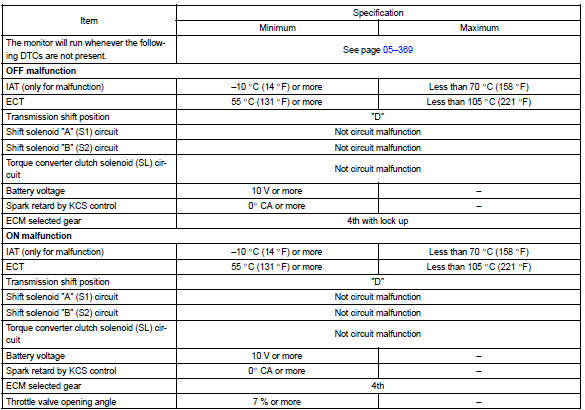Toyota Corolla (E120): System description
The ecm uses the signals from the throttle position sensor, air–flow meter and crankshaft position sensor to monitor the engagement condition of the lock–up clutch.
Then the ecm compares the engagement condition of the lock–up clutch with the lock–up schedule in the ecm memory to detect mechanical trouble of the shift solenoid valve sl, valve body and torque converter clutch or automatic transaxle (clutch, brake or gear etc.).

Monitor description
Based on the signals from the throttle position sensor, the airflow meter and the crankshaft position sensor, the ecm sends a signal to the shift solenoid valve sl to regulate the hydraulic pressure and provide smoother gearshifts. The shift–solenoid valve sl responds to commands from the ecm. The valve controls the lock–up relay valve to perform torque–converter lock–up and flexible lock–up functions.
The ecm compares the engine rpm (ne) signal and the input speed calculated by output speed sensor (output speed) and gear ratio to detect torque converter lock–up. The ecm then compares the lock–up status against the lock–up schedule in the ecm memory. If the ecm does not detect lock–up at the appropriate time, it will conclude that there is a malfunction of shift solenoid sl. The ecm will illuminate the mil.
Monitor strategy

Typical enabling condition

Typical malfunction thresholds

Other materials:
Hood
Release the lock from the inside of the vehicle to open the hood.
1 Pull the hood lock release lever.
The hood will pop up slightly.
2 Pull up the auxiliary catch lever and lift the hood.
3 Hold the hood open by inserting the support rod into the slot.
CAUTION
■Pre-driving check
C ...
Replacement
1. Remove battery
2. Remove battery carrier
Remove the 4 bolts and battery carrier.
3. Disconnect floor shift cable transmission control shift
Remove the nut from the control shaft lever.
disconnect the control cable from the control shaft lever.
remove the clip a ...
Replacement
Hint:
for parking brake cable assy no.2, Perform the same procedure to the parking
brake cable assy no.3.
1. Remove rear wheel
2. Remove rear brake drum sub–assy
3. Remove rear brake automatic adjust lever lh
4. Remove front brake shoe
sst 09718–00010
5. Remove parking brake sho ...


